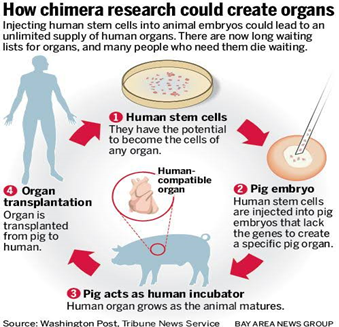Chimaeras: Genetic Marvels with Potential Human Organ Production
Human-Pig Chimaeras in Medical Research
- Human-pig chimaeras are being created in labs to explore systems capable of producing appropriately-sized human organs.
- With over 300,000 people awaiting organ transplants in India alone, the global shortage is a critical concern.
- Animals, from pigs to rats, have played a vital role in bridging the gap between organ donors and recipients.
Source: Washington Post
Animal Contributions in Medical Advances
- Past successes include the use of animal insulin and heart valves in human surgeries.
- Researchers aim to grow complete human organs within animals using induced pluripotent stem cells (iPSCs) technology.
- Controversy surrounds human iPSCs used in animal embryos, raising ethical questions yet to be fully addressed.
Natural Chimaeras in Nature
- Chimaeras, organisms with cells of different genetic makeups, exist in the animal kingdom.
- Examples include the half-sider budgerigar and the anglerfish, displaying varying degrees of chimerism.
- Human chimaeras documented in medical literature involve genetic changes in cells and fusion of fertilized zygotes.
Chimerism in Humans: Blood Types and Beyond
- Human chimerism can result from genetic changes in a cell, twin pregnancies merging into a single foetus, or absorbed foetuses in multiple pregnancies.
- Blood-group chimerism is relatively common during multiple births, often detected during routine blood tests.
- Individuals undergoing bone marrow transplants become chimeric as the donor’s stem cells repopulate the recipient’s blood cells.
Recent Breakthrough: Chimeric Monkey
- A recent study reported the successful creation of a live chimaeric monkey from Cynomolgus monkeys.
- Scientists modified embryonic stem cells, including a green fluorescent protein (GFP), and injected them into surrogate monkey embryos.
- The chimeric monkey exhibited GFP signals in various tissues, marking a milestone in creating chimaeras close to humans.
Future Implications
- This breakthrough opens avenues for non-human primates as models for biomedical applications.
While this scientific progress is promising, ethical challenges and limitations demand careful consideration before Human trial.




